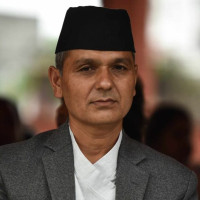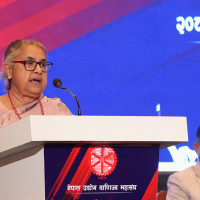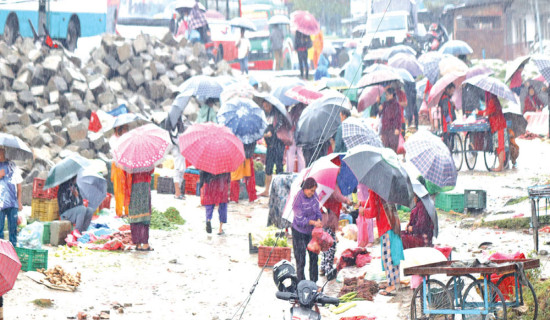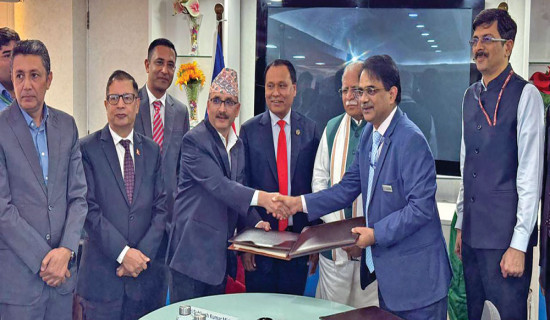- Sunday, 9 November 2025
Revenue mobilisation, capital expenditure below target in FY 2023/24
Kathmandu, July 17: The fiscal year 2023/24 has closed with less than satisfactory performance in both revenue mobilisation and capital expenditure by the government.
Despite various efforts and policy measures introduced to boost economic activities, the financial outcomes have fallen short of expectations.
According to the daily report of the Financial Comptroller General Office under the Ministry of Finance, revenue mobilisation of the government stood at only 74 per cent of the target while the capital expenditure stood at 63 per cent of the total allocation in the last fiscal year 2023/24.
The revenue collection of the government amounted to Rs. 1,058.89 billion which is 74.44 per cent of the initial annual target (Rs. 1,422.54 billion).
Out of total revenue collection, tax revenue stood at Rs. 944.55 billion or 72.35 per cent of the target and non-tax revenue stood at Rs. 114.34 billion or 97.68 per cent of the annual target.
Of the total revenue collection target of Rs 1,422.54 billion, the goal was to collect Rs. 1,305.4 billion tax revenue and Rs. 117.06 billion non-tax revenue in the last fiscal year.
During the last fiscal year, only Rs. 11.22 billion grant was received by the government. It is merely 22.48 per cent of the annual target of the government.
The government had set an annual target of receiving Rs. 49.94 billion grant in the fiscal year that ended on Monday.
However, the government received Rs. 23.85 billion under other receipts in the last fiscal year.
Even though revenue collection was lower than the target, it increased by 10.62 per cent in the last fiscal year as compared to previous fiscal year.
The government had collected revenue of Rs. 957.15 billion during the fiscal year 2022/23. It was only 68.21 per cent of the annual target of Rs. 1,403.14 billion.
Economist Dr. Chandra Mani Adhikari said that the revenue collection could not meet the target due to shrinking of economic activities against high projection.
“The government has been setting the revenue growth target considering the growth before COVID-19 pandemic which was around 15-20 per cent. But economic activities could not accelerate at present in line with the situation before the COVID-19 pandemic. So, the revenue collection remained far below the target,” he told The Rising Nepal.
In the meantime, sources of revenue such as domestic production, import, income and property transfer have been shrinking over the years which has also resulted in low revenue mobilisation, he said.
“The low capital expenditure has also become a challenge for the country not only for revenue mobilisation but also in economic growth. It is natural that when the capital expenditure did not increase, it hit revenue collection. There is multiple-prong impact of the capital expenditure on economy,” he said.
Budget deficit reaches Rs. 315 billion
Meanwhile, budget deficit of the government reached about Rs. 315 billion in the last fiscal year 2023/24.
During the last fiscal year, the total income of the government stood at Rs. 1,093.97 billion. This is 74.29 per cent of the annual receipts target of government.
In the last fiscal year, the government spent Rs. 1,408.76 billion. The government was in deficit during the last fiscal year due to higher expenses than the total income.
The government spent 80.44 per cent of the total budget allocation.
The government had introduced a budget of Rs. 1,751.31 billion for the last fiscal year 2023/24.
Of the total budget expenses, capital expenditure stood only at 63.47 per cent of total allocation in during the last fiscal year.Of the Rs. 302 billion allocated under capital expenditure, only Rs. 191.71 billion had been spent in the last fiscal year.
However, proportion of capital expenditure has increased during the last fiscal year as compared to previous fiscal year 2022/23.
The capital expenditure stood at 61.44 per cent of the total allocation in the previous fiscal year 2022/23.
The sluggish pace of work in the national pride projects as well as other projects has resulted in poor capital expenditure, said Dr. Adhikari.
“Weak project preparation, lack of effective project monitoring and hurdles seen during project implementation are major reasons behind the low capital expenditure this year too,” he said.
There is no alternative to increase budget under development works and spend properly to increase economic activities and improve revenue mobilisation in the coming years, he said.
The recurrent expenditure of the government stood at 83.41 per cent (Rs. 952.41 billion) during the last fiscal year. The government had allocated Rs. 1,141.78 billion under the heading of recurrent expenditure for the fiscal year.
Likewise, the government spent Rs. 264.63 billion under the heading of financing in the last fiscal year.
That is 86.07 per cent of the total allocation of Rs. 307.4 billion.
However, the government had revised the income and expenditure estimates in the mid-term review of the budget for the last fiscal year.
The Ministry of Finance had reduced the size of budget by about by Rs. 221 billion to Rs. 1,530.26 billion for the fiscal year.
By the end of the last fiscal year, it was estimated that around Rs. 1,309.30 billion would be generated form government sources (revenue and domestic borrowing), Rs. 40.12 billion from foreign grants and Rs. 180.83 billion from foreign loans.
The government had set a target of raising Rs. 1,240 billion from revenue, Rs. 49.94 billion from foreign grants, Rs. 212 billion from foreign loans and Rs. 240 billion from domestic borrowing.






-original-thumb.jpg)
-square-thumb.jpg)









